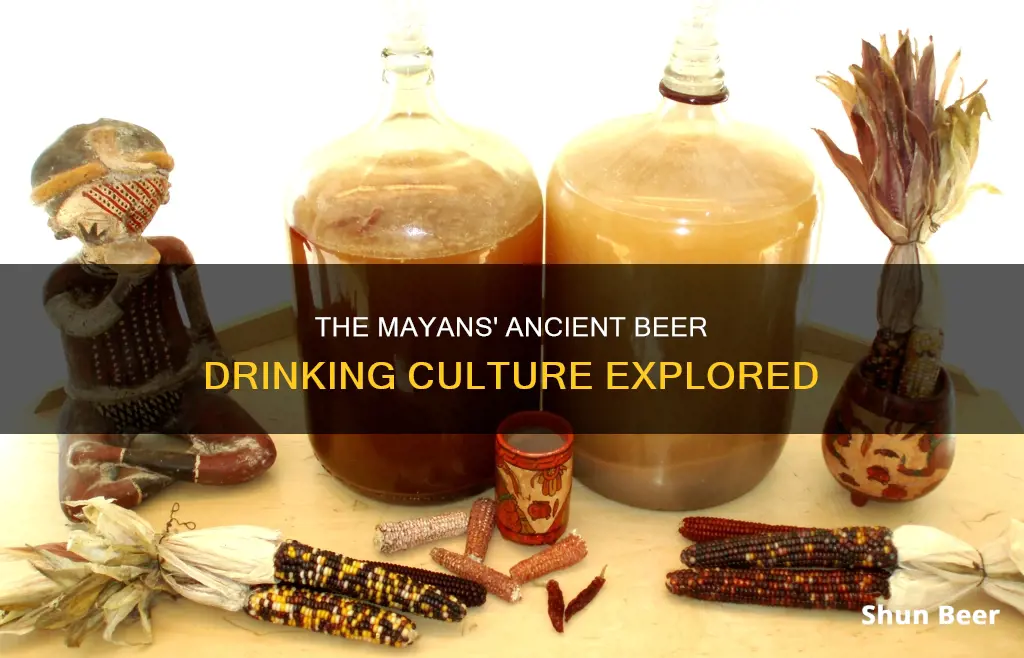
The ancient Mayans had a rich culture with a strong alcohol tradition, with their most popular drink being balché, a fermented mixture of honey and bark from the balché tree. They also drank pulque, made from the fermented juice of the maguey plant, and tepache, a fermented pineapple drink. The Mayans also brewed a foaming beer using cacao and maize.
| Characteristics | Values |
|---|---|
| Name of drink | Balché, pulque, tepache, pozol |
| Ingredients | Bark of the balché tree, honey, water, maize, cacao, pineapple, piloncillo or brown sugar, cinnamon, powder |
| Alcohol content | Mildly intoxicating, mildly alcoholic, low alcohol content |
| Rituals | Offered to the Gods during ceremonies and feasts |
| Drinking customs | People who threw up wore bags with their own vomit around their necks for the rest of the night |
What You'll Learn
- The Mayans drank balché, a mildly intoxicating beverage made from bark, honey and water
- Balché was used in rituals and to communicate with the gods
- The Mayans also drank pulque, an alcoholic beverage made from the fermented juice of the maguey plant
- Pulque was drunk in moderation daily, and in larger quantities during religious festivals and celebrations
- The Mayans also drank tepache, a fermented pineapple beverage

The Mayans drank balché, a mildly intoxicating beverage made from bark, honey and water
The Mayans, an indigenous people of Mexico and Central America, had a rich and fascinating culture. They were known for their advanced civilization, which flourished from around 2000 BC to 900 AD. While they are often remembered for their eye-catching temples and refined calendar, the Mayans also had a vibrant alcohol culture, with a preference for a drink called balché.
Balché was a mildly intoxicating beverage made from the bark of the balché tree (Lonchocarpus violaceus), honey, and water. The drink was fermented and commonly consumed by the ancient Maya in what is now Mexico and upper Central America. Even today, it is still popular among the Maya people. Balché was important to the Mayans, as they believed it helped them communicate with their Gods. They had a God of Alcohol, Drinking, and Drunkenness, named Acan, who was one of the most significant deities in their pantheon of over 100 Gods.
The Mayans were skilled beekeepers and used the honey they collected to make balché. They kept stingless bees in wooden hives and hollowed-out logs in the lowlands. The drink was consumed in large quantities during rituals and feasts, where it is said that those who vomited had to wear bags with their own vomit around their necks for the rest of the night.
Balché was not the only alcoholic beverage consumed by the Mayans. They also drank a beverage called pulque, made from the fermented juice or sap of the maguey plant (Agave americana). This drink was similar to beer and was also an important part of Mayan culture and mythology. It was consumed daily in moderate quantities and was also served in larger amounts during religious festivals and celebrations.
In addition to alcohol, the Mayans used other intoxicants such as peyote, magic mushrooms, morning glory seeds, and tobacco during official ceremonies. They believed that these substances helped them understand why things like illness, poor harvests, and meteorological events occurred. Overall, the Mayans had a rich and diverse culture surrounding alcohol and intoxicating substances, which played a significant role in their society and religious practices.
Beer and Hernia: What You Need to Know
You may want to see also

Balché was used in rituals and to communicate with the gods
The Mayans had a rich alcohol culture, with a wide variety of intoxicants to help them get closer to their gods. One of the most popular drinks was balché, a fermented mixture of honey and bark from the balché tree. The drink was mildly intoxicating and was consumed in large quantities during rituals and feasts.
Balché was important to the Mayans as it was named after their beloved god, Acan, who was in charge of alcohol, drinking, and intoxication. The Mayans knew over a hundred gods, and their favourite drink, balché, was offered to the gods during rituals and celebrations. The Mayans believed they could communicate directly with the spirits through intoxication, and so balché played a key role in their religious practices.
Balché was made from the bark of the Lonchocarpus violaceus tree, which was soaked in honey and water and then fermented. The Mayans were skilled beekeepers, and most of the honey they collected was used to make balché. The drink was also consumed in enema form to maximise its inebriating effects.
After the Spanish conquest of Central America in the 16th century, the Mayans' alcohol culture was viewed unfavourably by the strict Catholic Europeans. Spanish chroniclers and bishops described the drink as having a very strong flavour and a putrid odour. Despite this, the Mayans continued their rituals and the consumption of balché.
Balché holds a significant place in Mayan culture and history, not only as a popular beverage but also as a means to connect with their gods and understand the world around them.
Coffee Conundrum: Pee Smells Like Beer, Why?
You may want to see also

The Mayans also drank pulque, an alcoholic beverage made from the fermented juice of the maguey plant
The Mayans were no strangers to alcohol, with their rich culture and achievements coexisting alongside a strong drinking culture. While they are perhaps best known for drinking balché, a fermented mixture of honey and bark from the balché tree, they also drank pulque. Pulque is an alcoholic drink first consumed by the Maya, Aztecs, Huastecs, and other ancient Mesoamerican cultures. It is made from the fermented juice or sap of the maguey plant (*Agave americana*), similar to beer. The drink was only mildly alcoholic, but its potency was often increased with the addition of certain roots and herbs.
Pulque was an important part of daily life in ancient Mesoamerica, consumed in moderation throughout the region. However, it was also served in larger quantities during important religious festivals and celebrations such as weddings, fertility rites, and agricultural ceremonies. The drink even featured in Mesoamerican mythology, with its own personified goddess, Mayahuel, who was associated with fertility and sometimes referred to as "the woman of 400 breasts", likely referring to the milk-like sap of the maguey plant.
The consumption of pulque dates back to mythological times, with a myth explaining its invention. According to the story, the god Quetzalcoatl noticed that humans seemed miserable at the end of their workdays, so he decided to give them something to lift their spirits. He fell in love with the goddess Mayahuel, and they transformed into a tree with two branches. Mayahuel's grandmother, accompanied by demons, attacked the tree, splitting it into two and killing Mayahuel. Quetzalcoatl collected the remains of his lover and buried them, and from this, the first maguey plant grew, which humans used to make pulque.
The earliest depictions of pulque in Mesoamerican art date back to the great city of Teotihuacan, which flourished between 300 and 550 CE. Stone relief carvings from this period show masked figures with milky drops falling from their mouths, with one mask featuring a background of maguey leaves. Later, during the Post-classic period (900-1200 CE), a rock painting at Ixtapantongo depicted the goddess Mayahuel within a maguey plant, holding cups that likely contained pulque.
Cider and Beer: Mixing, Matching, and Drinking Safely
You may want to see also

Pulque was drunk in moderation daily, and in larger quantities during religious festivals and celebrations
Pulque was a drink first consumed by the Maya, Aztecs, Huastecs, and other Mesoamerican cultures. It is an alcoholic beverage made from the fermented juice or sap of the maguey plant (Agave americana), similar to beer. The drink was also referred to as octli by the Aztecs and chih by the Maya in the Nahuatl language.
Pulque was consumed in moderation daily throughout the region and was also served in larger quantities during important religious festivals and celebrations. These included weddings, fertility rites, and agricultural ceremonies. The drink was also closely associated with mythology and had its own personified goddess, Mayahuel, who was associated with fertility and sometimes referred to as "the woman of 400 breasts", likely referring to the milk-like sap of the maguey plant.
The consumption of pulque was also tied to mythology. According to one myth, the god Quetzalcoatl noticed that humans seemed miserable at the end of their workday, so he decided to give them something to lift their spirits. He fell in love with the goddess Mayahuel, and they escaped to Mesoamerica, where they transformed into a tree with two branches. Mayahuel's grandmother, accompanied by demons, attacked the tree, splitting it into two and killing Mayahuel. Quetzalcoatl collected the remains of his lover and buried them, and from these remains grew the first maguey plant, which was then used to make pulque.
The earliest artistic depictions of pulque in Mesoamerican art date back to the great city of Teotihuacan, which flourished between 300 and 550 CE. Stone relief carvings from this period show masked figures with milky drops falling from their mouths, suggesting the consumption of pulque.
Head Injuries and Alcohol: What You Should Know
You may want to see also

The Mayans also drank tepache, a fermented pineapple beverage
The Mayans were certainly no strangers to alcohol. They had a rich alcohol culture, with a wide variety of intoxicants at their disposal, including peyote, magic mushrooms, morning glory seeds, tobacco, and, of course, booze. While the most popular drink was balche, a fermented mixture of honey and bark from the balche tree, the Mayans also drank tepache, a fermented pineapple beverage.
Tepache is made from the peel and rind of pineapples, sweetened with piloncillo or brown sugar, seasoned with powdered cinnamon, and served cold. Although it is fermented for several days, tepache does not contain much alcohol. Its taste is reminiscent of beer, but it is sweet. The word "tepache" comes from the Nahuatl "tepiatl", meaning "corn drink", derived from the words "tepitl" (tender corn) and "atl" (water).
The custom of making tepache with corn continues in several communities, especially among indigenous people in Mexico, where a higher alcohol content version was used for religious ceremonies. In these communities, tepache is made by fermenting the juice and pulp of various types of sweet fruits, such as pineapple, guava, apple, tuna, or orange. The longer the mixture is left to ferment, the more alcoholic, bitter, and acidic it becomes.
The Mayans also consumed other alcoholic drinks, such as pulque, made from the fermented juice or sap of the maguey plant, and chocolate-based beer, brewed with maize and cacao.
Thawing Frozen Beer: Is Drinking Safe?
You may want to see also
Frequently asked questions
The Mayans drank a fermented alcoholic beverage made from corn and cacao. They also drank a beverage called balché, made from honey and the bark of the balché tree, which was mildly intoxicating.
Balché was a popular drink in ancient Mayan culture, consumed during rituals and feasts. It was made from honey and the bark of the balché tree, which was soaked and fermented. It is still consumed by the Maya today.
Balché was considered sacred by the Mayans, who believed it brought them closer to their gods. The Mayans also consumed other intoxicants like peyote, magic mushrooms, morning glory seeds, and tobacco during official ceremonies.
The Mayans also drank pulque, an alcoholic beverage made from the fermented juice or sap of the maguey plant, similar to beer. Pulque was featured in several Mesoamerican myths and was consumed during important religious festivals and celebrations.







